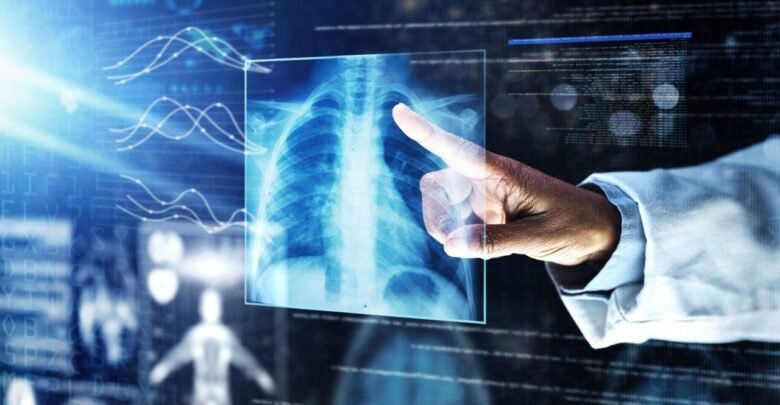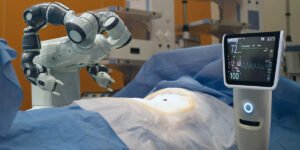The integration of artificial intelligence (AI) is bringing dramatic changes to the ever-changing world of healthcare. This is most clearly visible in radiology. Radiology used to rely on the sharp eye of the radiologist to understand complex images. However, things are changing in radiology as AI systems become increasingly important to the diagnostic process. This article describes how artificial intelligence is changing radiology, and how new technologies are improving diagnosis, working more efficiently, and changing the future of medical imaging.
Changes in Radiology Over Time
- From analog to digital: Radiology has come a long way since the days of the movies. The move to digital imaging has made images clearer and allowed people to store and share them electronically, making the use of artificial intelligence possible.
- The rise of medical imaging: Medical imaging tools such as X-rays, CT scans, MRIs, and ultrasounds have come a long way and are now used to diagnose and target a wide range of health problems. However, such large amounts of data make analysis and understanding more difficult.
- The Role of Artificial Intelligence in Radiology: When artificial intelligence intervenes in imaging, it is a major step forward. The ability of AI algorithms to quickly and correctly view large data sets is changing the way medical images are understood and how radiologists solve diagnostic problems.
What Artificial Intelligence Means for Radiological Diagnostics?
- Better image analysis: Artificial intelligence is very good at analyzing images and can do this very quickly and accurately. Complementing and enhancing the skills of human radiologists, algorithms can detect subtle abnormalities, identify trends, and thoroughly examine images.
- Diseases can be detected early: Early identification is an important part of improving patient health. Artificial intelligence can help detect signs and problems in medical images early, when treatments are more likely to be effective, allowing earlier detection of diseases such as cancer.
- Workflow that works well: Artificial intelligence speeds up the work of radiologists by automating routine tasks. This allows radiologists to focus on the more difficult parts of the diagnosis, making the entire process more efficient and reducing the time it takes to deliver results.
Real-World Applications of Artificial Intelligence in Radiology
- MRI and CT Image Analysis: Artificial intelligence is getting better at understanding the meaning of MRI and CT images. Algorithms can help doctors make more accurate and consistent decisions by identifying problems and measuring their changes over time.
- Breast Cancer Screening: Breast imaging is improving thanks to artificial intelligence, which helps detect breast cancer during mammograms. Radiologists can use this technology to spot small signs that may indicate early-stage cancer.
- Find Broken Bones: X-rays can show broken bones, and AI algorithms are good at finding them. The app speeds up the diagnostic process, allowing fracture patients to get help quickly.
Things to Think About in AI Radiology
- Data security and privacy: When AI is used for imaging, it looks at private photos of patients. To protect patient information and ensure that people trust these technologies, it is important to ensure that strong data privacy and security measures are in place.
- Solve tough problems: AI is very good at simple image analysis, but for complex cases that require an in-depth understanding of clinical situations, it can still be difficult to figure out what’s going on. In these cases, collaboration between AI and human doctors is important.
- Integrate with existing systems: It can be difficult to get AI to work well with existing radiology tools. Compatibility issues, whether training is required, and whether standardized standards are needed are all issues that should be seriously considered.
Future Directions of Artificial Intelligence in Radiology
- Predictive Analytics Enabled by Artificial Intelligence: Predictive analytics is part of the future of artificial intelligence in imaging. When doctors use algorithms to look at past data and guess how a disease will progress, what complications might arise, and how treatments will work, they can make better choices.
- Biomarkers for Quantitative Imaging: Quantitative image signals are improving with the help of artificial intelligence. These biomarkers are objective, measurable signs of disease that can help doctors make more accurate diagnoses and develop more personalized treatment plans.
- Applications of Artificial Intelligence in Interventional Radiology: Shortly, artificial intelligence will be used in interventional radiotherapy. Artificial intelligence can help make real-time decisions during processes, improving accuracy and reducing risk.
How to Solve Past Problems: A Collective Approach
- Training and education: To apply artificial intelligence to radiology, medical personnel need continuous education and training. For radiologists to use AI tools effectively in their work, they need a deep understanding of these tools.
- Regulatory framework: Clear rules need to be put in place to ensure that AI is used for imaging safely and ethically. Regulation should cover aspects such as data protection, openness of algorithms, and security of artificial intelligence technology.
- Always work together: Collaboration is important for AI developers, radiologists, and healthcare companies. Continuous collaboration and communication make it easier to improve AI algorithms based on assessments and clinical insights from real-world situations.
Conclusion
The impact of artificial intelligence on radiology goes beyond figuring out what images mean; they mark the beginning of a new era in healthcare. As technology and expertise converge, the way we diagnose and care for patients is changing. Artificial intelligence is getting better and radiologists are at the forefront of the technological revolution. When human intelligence and artificial intelligence work together, they can make radiological diagnostics more accurate, faster, and more personalized. With the shift from analog to digital, artificial intelligence is now deeply integrated, showing not only a change in the instruments but also a paradigm shift in the way radiology works.
FAQs
1. How does AI improve the accuracy of medical imaging?
Artificial intelligence improves diagnostic accuracy by becoming very good at analyzing images. Algorithms can spot subtle problems and trends and provide accuracy and speed beyond the capabilities of human radiologists, helping to make more accurate diagnoses.
2. In addition to common imaging methods, what are some practical applications of artificial intelligence in medicine?
In the field of imaging, AI can be used for various purposes, such as analyzing MRI and CT scans, detecting breast cancer through mammograms, and detecting bone fractures through X-rays. Using these apps can make the testing process faster and more accurate.
3. What challenges does artificial intelligence face in radiology departments, especially when reading complex cases?
AI is very good at simple image analysis, but for complex cases that require an in-depth understanding of clinical situations, it can still be difficult to figure out what’s going on. AI and human doctors must work together to solve difficult diagnostic problems.
4. What role can artificial intelligence play in the future of radiology, especially in the areas of personalized care planning and predictive analytics?
Predictive analytics is the future of artificial intelligence in radiology. This is when computers look at old data to guess how a disease will progress and how treatments will work. Artificial intelligence can also help create quantitative imaging biomarkers, making assessments more accurate and enabling more personalized treatment plans.
5. What steps are being taken to address issues such as data protection and adding artificial intelligence to existing radiology systems?
Many issues with AI imaging will need to be resolved over time. We take strong data privacy and security measures to protect patient information. In addition, researchers are exploring ways to seamlessly integrate AI into current radiology systems, taking into account factors such as standardization, compatibility, and training.



